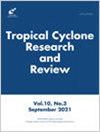了解热带气旋的生命周期
IF 4.1
4区 地球科学
Q3 METEOROLOGY & ATMOSPHERIC SCIENCES
引用次数: 0
摘要
讨论了在静态环境中理想的三维数值模拟中理解热带气旋生命周期物理的概念框架。讨论了轴对称框架和三维框架。两个轴对称框架之一的中心特征是假设绝对角动量在摩擦边界层以上是物质守恒的,至少在经典的埃利亚森平衡公式中是这样。这种守恒意味着涡旋向上需要摩擦层上方径向流入,而摩擦层上方径向流出导致涡旋向下。许多想法都可以通过两个简单的实验室实验来说明。在另一个轴对称框架,即所谓的WISHE框架中,绝对角动量的物质守恒被省略,而有利于假设饱和湿等效位涡处处为零。这一假设充其量限制了WISHE框架在风暴生命周期的一小部分的适用性,即使人们能够证明由此引入的隐含角动量源是正确的。最近对热带气旋生命周期的三维数值模拟分析揭示了这些模式所依据的假设的因果关系问题。在三维框架中,旋转对流范式强调了深层、对流诱导的翻转环流的涡旋上升的重要性,在边界层普遍存在产生流出的趋势的情况下,涡旋上升足以在摩擦边界层上方产生流入。当深层对流太弱而不能将所有在边界层辐合到对流层上层的质量通气时,边界层上方出现净外流,涡旋减弱。这种行为似乎被排除在WISHE模型中,因为他们假设全球湿润中性,但这是经典Eliassen模型的一个特征。本文章由计算机程序翻译,如有差异,请以英文原文为准。
Towards understanding the tropical cyclone life cycle
Conceptual frameworks are discussed for understanding the physics of the tropical cyclone life cycle in an idealized, three-dimensional, numerical simulation in a quiescent environment. Both axisymmetric and three-dimensional frameworks are discussed. A central feature of one of the two axisymmetric frameworks is the assumption that absolute angular momentum is materially conserved above the frictional boundary layer, at least in the classical Eliassen balance formulation. Such conservation implies that vortex spin up requires radial inflow above the friction layer, while radial outflow there leads to spin down. Many of the ideas are illustrated by two simple laboratory experiments.
In the other axisymmetric framework, the so-called WISHE framework the material conservation of absolute angular momentum is dispensed with in favour of assuming that the saturated moist equivalent potential vorticity is everywhere zero. This assumption limits the applicability of the WISHE framework at best to a small portion of the storm’s life cycle, even if one were able to justify the implicit angular momentum source thereby introduced. Analysis of a recent three-dimensional numerical simulation of the tropical cyclone life cycle unveils a causality problem with the assumptions underlying these models.
In a three-dimensional framework, the rotating-convection paradigm highlights the importance for vortex spin up of the deep, convectively-induced overturning circulation being strong enough to generate inflow above the frictional boundary layer in the presence of the ubiquitous tendency of the boundary layer to generate outflow there. When deep convection is too weak to ventilate all the mass that is converging in the boundary layer to the upper troposphere, there is net outflow above the boundary layer and the vortex weakens. This behaviour appears to be ruled out in the WISHE models by their assumption of global moist neutrality, but is a feature of the classical Eliassen model.
求助全文
通过发布文献求助,成功后即可免费获取论文全文。
去求助
来源期刊

Tropical Cyclone Research and Review
METEOROLOGY & ATMOSPHERIC SCIENCES-
CiteScore
4.60
自引率
3.40%
发文量
184
审稿时长
30 weeks
期刊介绍:
Tropical Cyclone Research and Review is an international journal focusing on tropical cyclone monitoring, forecasting, and research as well as associated hydrological effects and disaster risk reduction. This journal is edited and published by the ESCAP/WMO Typhoon Committee (TC) and the Shanghai Typhoon Institute of the China Meteorology Administration (STI/CMA). Contributions from all tropical cyclone basins are welcome.
Scope of the journal includes:
• Reviews of tropical cyclones exhibiting unusual characteristics or behavior or resulting in disastrous impacts on Typhoon Committee Members and other regional WMO bodies
• Advances in applied and basic tropical cyclone research or technology to improve tropical cyclone forecasts and warnings
• Basic theoretical studies of tropical cyclones
• Event reports, compelling images, and topic review reports of tropical cyclones
• Impacts, risk assessments, and risk management techniques related to tropical cyclones
 求助内容:
求助内容: 应助结果提醒方式:
应助结果提醒方式:


